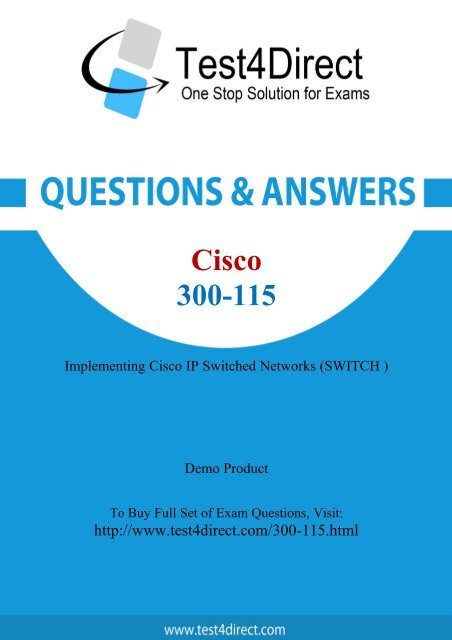Buy 300-115 BrainDumps and Get Discount
Test4Direct provides latest PDF questions of Cisco 300-115 exam. You have an opportunity to pass the Cisco 300-115 exam in one go. Test4Direct is most accurate source to prepare Cisco 300-115 exam as your success will become site’s responsibility after purchasing 300-115 exam product. There are also lots of discounts and promotion offers that you can avail. Let’s try a free demo http://www.test4direct.com/300-115.html
Test4Direct provides latest PDF questions of Cisco 300-115 exam. You have an opportunity to pass the Cisco 300-115 exam in one go. Test4Direct is most accurate source to prepare Cisco 300-115 exam as your success will become site’s responsibility after purchasing 300-115 exam product. There are also lots of discounts and promotion offers that you can avail. Let’s try a free demo http://www.test4direct.com/300-115.html
You also want an ePaper? Increase the reach of your titles
YUMPU automatically turns print PDFs into web optimized ePapers that Google loves.
Cisco<br />
<strong>300</strong>-<strong>115</strong><br />
Implementing Cisco IP Switched Networks (SWITCH )<br />
Demo Product<br />
To <strong>Buy</strong> Full Set of Exam Questions, Visit:<br />
http://www.test4direct.com/<strong>300</strong>-<strong>115</strong>.html
Question: 1<br />
Version: 15.0<br />
What is the maximum number of switches that can be stacked using Cisco StackWise?<br />
A. 4<br />
B. 5<br />
C. 8<br />
D. 9<br />
E. 10<br />
F. 13<br />
Question: 2<br />
Question: 3<br />
Question: 4<br />
Answer: D<br />
A network engineer wants to add a new switch to an existing switch stack. Which configuration must<br />
be added to the new switch before it can be added to the switch stack?<br />
A. No configuration must be added.<br />
B. stack ID<br />
C. IP address<br />
D. VLAN information<br />
E. VTP information<br />
What percentage of b<strong>and</strong>width is reduced when a stack cable is broken?<br />
A. 0<br />
B. 25<br />
C. 50<br />
D. 75<br />
E. 100<br />
Refer to the exhibit.<br />
Answer: A<br />
Answer: C
Which set of configurations will result in all ports on both switches successfully bundling into an<br />
EtherChannel?<br />
A. switch1<br />
channel-group 1 mode active<br />
switch2<br />
channel-group 1 mode auto<br />
B. switch1<br />
channel-group 1 mode desirable<br />
switch2<br />
channel-group 1 mode passive<br />
C. switch1<br />
channel-group 1 mode on<br />
switch2<br />
channel-group 1 mode auto<br />
D. switch1<br />
channel-group 1 mode desirable<br />
switch2<br />
channel-group 1 mode auto<br />
Question: 5<br />
Refer to the exhibit.<br />
Answer: D<br />
How can the traffic that is mirrored out the GigabitEthernet0/48 port be limited to only traffic that is<br />
received or transmitted in VLAN 10 on the GigabitEthernet0/1 port?<br />
A. Change the configuration for GigabitEthernet0/48 so that it is a member of VLAN 10.<br />
B. Add an access list to GigabitEthernet0/48 to filter out traffic that is not in VLAN 10.<br />
C. Apply the monitor session filter globally to allow only traffic from VLAN 10.<br />
D. Change the monitor session source to VLAN 10 instead of the physical interface.<br />
Question: 6<br />
Refer to the exhibit.<br />
Answer: C
A network engineer wants to analyze all incoming <strong>and</strong> outgoing packets for an interface that is<br />
connected to an access switch. Which three items must be configured to mirror traffic to a packet<br />
sniffer that is connected to the distribution switch? (Choose three.)<br />
A. A monitor session on the distribution switch with a physical interface as the source <strong>and</strong> the<br />
remote SPAN VLAN as the destination<br />
B. A remote SPAN VLAN on the distribution <strong>and</strong> access layer switch<br />
C. A monitor session on the access switch with a physical interface source <strong>and</strong> the remote SPAN<br />
VLAN as the destination<br />
D. A monitor session on the distribution switch with a remote SPAN VLAN as the source <strong>and</strong> physical<br />
interface as the destination<br />
E. A monitor session on the access switch with a remote SPAN VLAN source <strong>and</strong> the physical interface<br />
as the destination<br />
F. A monitor session on the distribution switch with a physical interface as the source <strong>and</strong> a physical<br />
interface as the destination<br />
Question: 7<br />
Question: 8<br />
Question: 9<br />
Answer: B, C, D<br />
After an EtherChannel is configured between two Cisco switches, interface port channel 1 is in the<br />
down/down state. Switch A is configured with channel-group 1 mode active, while Switch B is<br />
configured with channel-group 1 mode desirable. Why is the EtherChannel bundle not working?<br />
A. The switches are using mismatched EtherChannel negotiation modes.<br />
B. The switch ports are not configured in trunking mode.<br />
C. LACP priority must be configured on both switches.<br />
D. The channel group identifier must be different for Switch A <strong>and</strong> Switch B.<br />
Answer: A<br />
An EtherChannel bundle has been established between a Cisco switch <strong>and</strong> a corporate web server.<br />
The network administrator noticed that only one of the EtherChannel links is being utilized to reach<br />
the web server. What should be done on the Cisco switch to allow for better EtherChannel utilization<br />
to the corporate web server?<br />
A. Enable Cisco Express Forwarding to allow for more effective traffic sharing over the EtherChannel<br />
bundle.<br />
B. Adjust the EtherChannel load-balancing method based on destination IP addresses.<br />
C. Disable spanning tree on all interfaces that are participating in the EtherChannel bundle.<br />
D. Use link-state tracking to allow for improved load balancing of traffic upon link failure to the<br />
server.<br />
E. Adjust the EtherChannel load-balancing method based on source IP addresses.<br />
Answer: E
Interface FastEthernet0/1 is configured as a trunk interface that allows all VLANs. This comm<strong>and</strong> is<br />
configured globally:<br />
monitor session 2 filter vlan 1 - 8, 39, 52<br />
What is the result of the implemented comm<strong>and</strong>?<br />
A. All VLAN traffic is sent to the SPAN destination interface.<br />
B. Traffic from VLAN 4 is not sent to the SPAN destination interface.<br />
C. Filtering a trunked SPAN port effectively disables SPAN operations for all VLANs.<br />
D. The trunk's native VLAN must be changed to something other than VLAN 1.<br />
E. Traffic from VLANs 1 to 8, 39, <strong>and</strong> 52 is replicated to the SPAN destination port.<br />
Question: 10<br />
Question: 11<br />
Question: 12<br />
Answer: E<br />
A network engineer notices inconsistent Cisco Discovery Protocol neighbors according to the<br />
diagram that is provided. The engineer notices only a single neighbor that uses Cisco Discovery<br />
Protocol, but it has several routing neighbor relationships. What would cause the output to show<br />
only the single neighbor?<br />
A. The routers are connected via a Layer 2 switch.<br />
B. IP routing is disabled on neighboring devices.<br />
C. Cisco Express Forwarding is enabled locally.<br />
D. Cisco Discovery Protocol advertisements are inconsistent between the local <strong>and</strong> remote devices.<br />
Answer: A<br />
After the implementation of several different types of switches from different vendors, a network<br />
engineer notices that directly connected devices that use Cisco Discovery Protocol are not visible.<br />
Which vendor-neutral protocol could be used to resolve this issue?<br />
A. Local Area Mobility<br />
B. Link Layer Discovery Protocol<br />
C. NetFlow<br />
D. Directed Response Protocol<br />
Answer: B<br />
Several new switches have been added to the existing network as VTP clients. All of the new switches<br />
have been configured with the same VTP domain, password, <strong>and</strong> version. However, VLANs are not<br />
passing from the VTP server (existing network) to the VTP clients. What must be done to fix this?<br />
A. Remove the VTP domain name from all switches with "null" <strong>and</strong> then replace it with the new<br />
domain name.
B. Configure a different native VLAN on all new switches that are configured as VTP clients.<br />
C. Provision one of the new switches to be the VTP server <strong>and</strong> duplicate information from the<br />
existing network.<br />
D. Ensure that all switch interconnects are configured as trunks to allow VTP information to be<br />
transferred.<br />
Question: 13<br />
Question: 14<br />
Answer: D<br />
After implementing VTP, the extended VLANs are not being propagated to other VTP switches. What<br />
should be configured for extended VLANs?<br />
A. VTP does not support extended VLANs <strong>and</strong> should be manually added to all switches.<br />
B. Enable VTP version 3, which supports extended VLAN propagation.<br />
C. VTP authentication is required when using extended VLANs because of their ability to cause<br />
network instability.<br />
D. Ensure that all switches run the same Cisco IOS version. Extended VLANs will not propagate to<br />
different IOS versions when extended VLANs are in use.<br />
Refer to the exhibit.<br />
Answer: B<br />
Switch A, B, <strong>and</strong> C are trunked together <strong>and</strong> have been properly configured for VTP. Switch C receives<br />
VLAN information from the VTP server Switch A, but Switch B does not receive any VLAN<br />
information. What is the most probable cause of this behavior?<br />
A. Switch B is configured in transparent mode.<br />
B. Switch B is configured with an access port to Switch A, while Switch C is configured with a trunk<br />
port to Switch B.<br />
C. The VTP revision number of the Switch B is higher than that of Switch A.<br />
D. The trunk between Switch A <strong>and</strong> Switch B is misconfigured.<br />
Question: 15<br />
Refer to the exhibit.<br />
Answer: A
Switch A, B, <strong>and</strong> C are trunked together <strong>and</strong> have been properly configured for VTP. Switch B has all<br />
VLANs, but Switch C is not receiving traffic from certain VLANs. What would cause this issue?<br />
A. A VTP authentication mismatch occurred between Switch A <strong>and</strong> Switch B.<br />
B. The VTP revision number of Switch B is higher than that of Switch A.<br />
C. VTP pruning is configured globally on all switches <strong>and</strong> it removed VLANs from the trunk interface<br />
that is connected to Switch C.<br />
D. The trunk between Switch A <strong>and</strong> Switch B is misconfigured.<br />
Answer: C
THANKS FOR TRYING THE DEMO OF OUR PRODUCT<br />
Visit Our Site to Purchase the Full Set of Actual <strong>300</strong>-<strong>115</strong> Exam Questions With Answers.<br />
http://www.test4direct.com/<strong>300</strong>-<strong>115</strong>.html<br />
We Also Provide Practice Exam Software That Simulates Real Exam Environment And Has<br />
Many Self-Assessment Features. Download Free Product Demo From:<br />
http://www.test4direct.com/<strong>300</strong>-<strong>115</strong>.html<br />
Money Back Guarantee<br />
Check Out Our Customer Testimonials

















